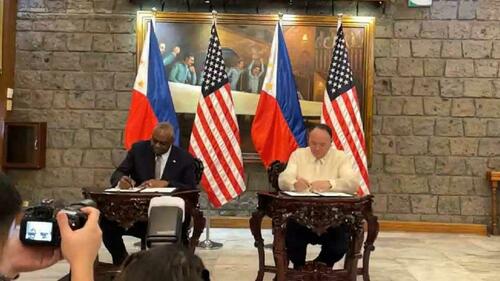The Pentagon has made deeper, permanent inroads into southeast Asia, on Monday announcing a major new deal inked by the US and Philippine defense chiefs to share classified military information and technology.
US Defense Secretary Lloyd Austin and his Philippine counterpart Gilberto Teodoro kicked off Austin's visit to Manila this week with the signing of the General Security of Military Information Agreement. Monday's events also included a closed-door meeting between the Pentagon chief and President Ferdinand Marcos.
The deal has been described as allowing the Philippines access to "higher capabilities and big-ticket items" from the US and "open opportunities to pursue similar agreements with like-minded nations," according to Philippine Assistant Defense Secretary Arsenio Andolong.
 Via AFP
Via AFPBeijing is sure to also take note of the newly opened combined command and coordination center inside the Philippine military's headquarters in the capital. Teodoro and Austin formally inaugurated it on Monday.
"This center will enable real-time information sharing for a common operating picture. It will help boost interoperability for many, many years to come," Austin said at the ceremony. "It will be a place where our forces can work side by side to respond to regional challenges," he added.
Philippine military chief General Romeo Brawner hailed the establishment of the joint command center, saying it will "enhance our ability to collaborate during crises, fostering an environment where our strengths combine to safeguard peace and security in our region."
As expected, China blasted the development, with its foreign ministry spokesman Lin Jian responding by warning any military agreement or security arrangement must not target "any third party or harm a third party's interests - let alone undermine regional peace, exacerbate regional tensions."
Of course, the US and the Philippines are already defense treaty partners, which has long injected extra tensions as rival patrols in regional waters come up against each other:
China has brushed aside an international ruling that its claims in the South China Sea have no legal basis, and has deployed navy and coast guard vessels that Manila says harass its vessels and stop them accessing some reefs and islands in the waters.
This has led to violent confrontations that have resulted in injuries to Filipino personnel and damage to their vessels in the past 18 months.
That has sparked concern the United States could be drawn into an armed conflict due to its mutual defense treaty with the Philippines.
This new military intelligence and defense tech sharing agreement, along with the inaugurated command center, further solidifies Washington's presence in the region.
Dramatic scenes like the below have been on the increase of late:
WATCH: Two China Coast Guard ships use their water cannons on the much smaller Philippine Navy-contracted Unaizah May 4 during a March 5 resupply mission to Ayungin Shoal. The Philippines says the water cannons shattered the wind shield of the resupply ship, injuring four on… pic.twitter.com/6d28CMFwuj
— Rappler (@rapplerdotcom) March 5, 2024
On the other side of the globe, China seems bent on teaching the US a lesson, in expanding its own intelligence and military presence in places like Cuba, not far off America's coast. Beijing without doubt sees its inroads into Latin America as a necessary response to America's expanding Pacific presence.
Source link

